Employee recognition drives retention, engagement, and performance. Studies consistently demonstrate that employees who feel genuinely valued demonstrate higher productivity, stronger organizational commitment, and significantly lower turnover intention. Yet many organizations struggle to implement recognition programs that achieve consistent visibility, meaningful engagement, and sustained impact.
Digital touchscreen displays designed for employee recognition provide businesses with dynamic, engaging platforms that celebrate contributions year-round, not just during annual ceremonies. These interactive systems enable rich multimedia storytelling, allow real-time content updates, and create public-facing tributes that honor excellence while inspiring colleagues and connecting with visitors.
This comprehensive guide explores how organizations can implement touchscreen displays for employee recognition, examining content strategies, implementation approaches, ROI considerations, and real-world applications that transform how businesses recognize and celebrate their most valuable asset: exceptional employees.
The Business Case for Employee Recognition Technology
The workplace recognition landscape has fundamentally shifted, with modern employees expecting regular, meaningful acknowledgment of their contributions.
Employee Recognition Statistics and Trends
According to Gallup research, employee recognition remains one of the most cost-effective ways to increase engagement and retention. Organizations with robust recognition programs experience:
- 31% lower voluntary turnover rates compared to organizations with poor recognition cultures
- 2.5x higher employee engagement scores in organizations with regular recognition
- 14% increase in productivity and performance metrics when employees feel recognized
The Society for Human Resource Management (SHRM) reports that employee recognition programs demonstrate measurable ROI, with every dollar invested in meaningful recognition generating up to $3 in increased productivity, reduced turnover costs, and improved organizational culture.
The Cost of Employee Turnover
Employee turnover represents one of the most significant controllable costs for modern organizations. The Society for Human Resource Management estimates that replacing an employee costs an average of 6-9 months of that employee’s salary when factoring in recruitment, onboarding, training, and productivity ramp-up time.
For a mid-sized organization with 200 employees and average turnover of 15%, annual turnover costs can easily exceed $500,000. Recognition programs that reduce turnover by even 5-10 percentage points generate substantial financial returns while preserving institutional knowledge and maintaining team continuity.
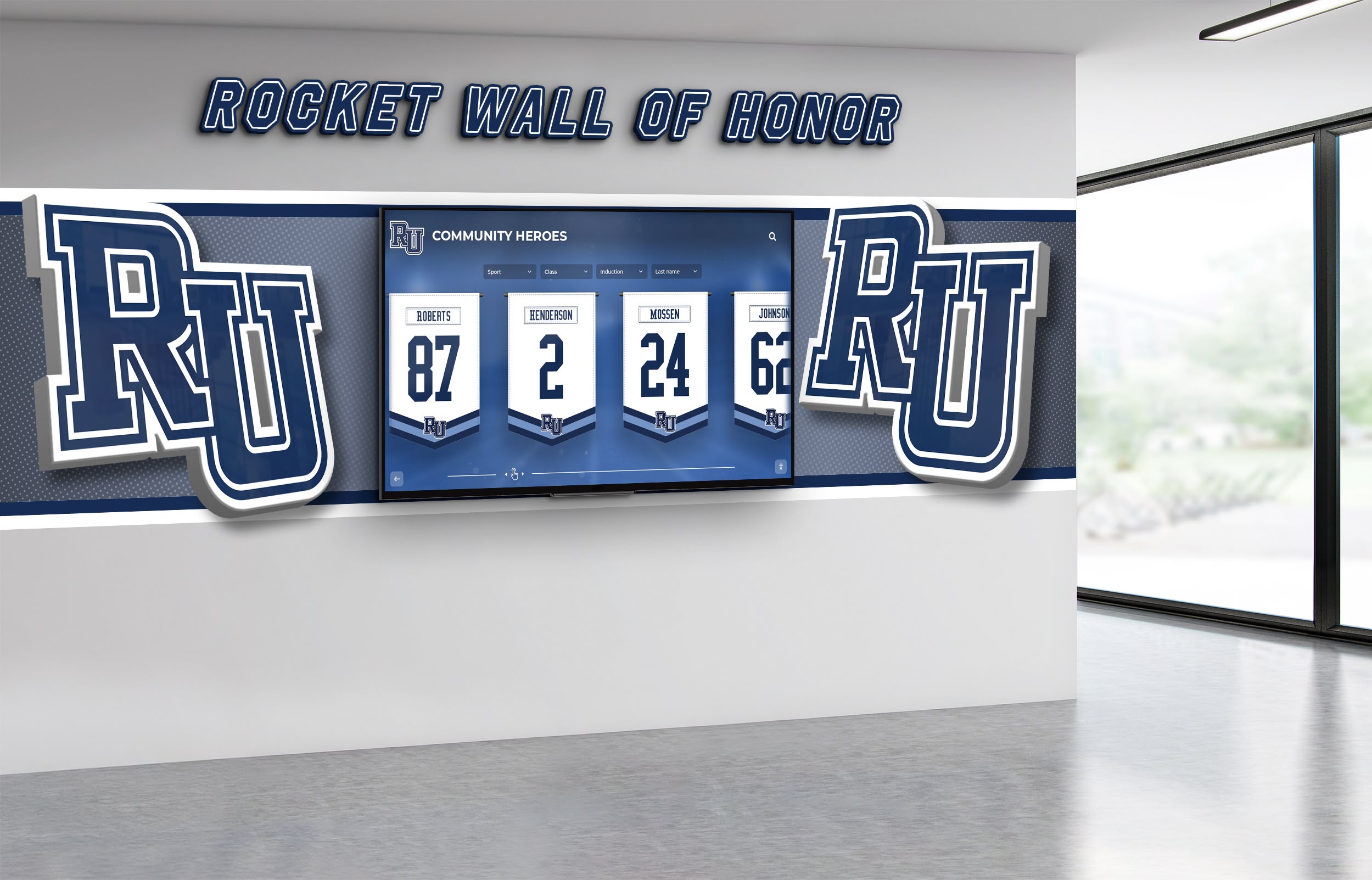
Recognition’s Impact on Employee Engagement
Engaged employees demonstrate 18% higher productivity, 23% higher profitability, and 41% lower absenteeism compared to disengaged employees, according to Gallup’s State of the Global Workplace report. Recognition serves as a primary driver of engagement, validating contributions and reinforcing desired behaviors.
Digital recognition displays create visible, tangible manifestations of appreciation culture. When employees, clients, and visitors see colleagues honored prominently, it reinforces the organization’s values and elevates performance to its rightful position as celebrated, valued work deserving public acknowledgment.
Understanding Employee Recognition Touchscreen Displays
Interactive touchscreen displays offer unique capabilities specifically valuable for honoring employees in corporate environments.
What Are Employee Recognition Touchscreen Displays?
Employee recognition touchscreen displays combine large-format digital screens (typically 43-75 inches) with touch-sensitive interfaces, mounting systems, and specialized software designed for showcasing employee achievements, company milestones, and values-aligned behaviors. Unlike static bulletin boards or digital slideshow displays, these interactive systems allow users to explore content actively—browsing employee profiles, watching recognition videos, reading peer testimonials, and discovering achievement histories.
Modern touchscreen technology provides intuitive interaction requiring no technical knowledge. Employees, visitors, and clients simply touch the screen to navigate, similar to smartphones or tablets but with much larger displays optimized for public spaces.
Key Features for Employee Recognition
Rich Multimedia Content: Touchscreen displays support diverse content types that bring employee recognition to life:
- Professional photographs showcasing employees in action
- Video tributes featuring colleagues, leaders, and clients
- Written biographies detailing career achievements and contributions
- Peer recognition messages and appreciation testimonials
- Award acknowledgments and certifications
- Personal achievement statements in employees’ own words
Interactive Exploration: Unlike static displays showing limited information, interactive systems allow users to discover extensive content about each recognized employee:
- Detailed career histories and professional backgrounds
- Expertise areas and specialized skills
- Years of service and career milestones
- Professional development achievements
- Community involvement and volunteer work
- Personal interests and hobbies humanizing team members
Real-Time Updates and Additions: Digital platforms enable continuous recognition, not just annual events:
- Welcome new employees with immediate profile additions
- Celebrate milestones like service anniversaries and promotions
- Acknowledge awards, certifications, and professional achievements
- Feature rotating “Employee Spotlight” content throughout the year
- Update photos and information as careers progress
- Add peer and client testimonials continuously
Advantages Over Traditional Recognition Methods
Traditional Recognition Walls:
- Limited space constraining content
- Static photos and text
- Difficult and time-consuming to update
- Easily overlooked in hallways
- Subject to fading, damage, and wear
- Capacity limits on employees featured
Interactive Touchscreen Displays:
- Virtually unlimited content capacity
- Rich multimedia with photos, video, audio
- Easy digital updates in minutes
- Eye-catching and engaging for viewers
- Professional, permanent presentation
- Every employee can be featured prominently
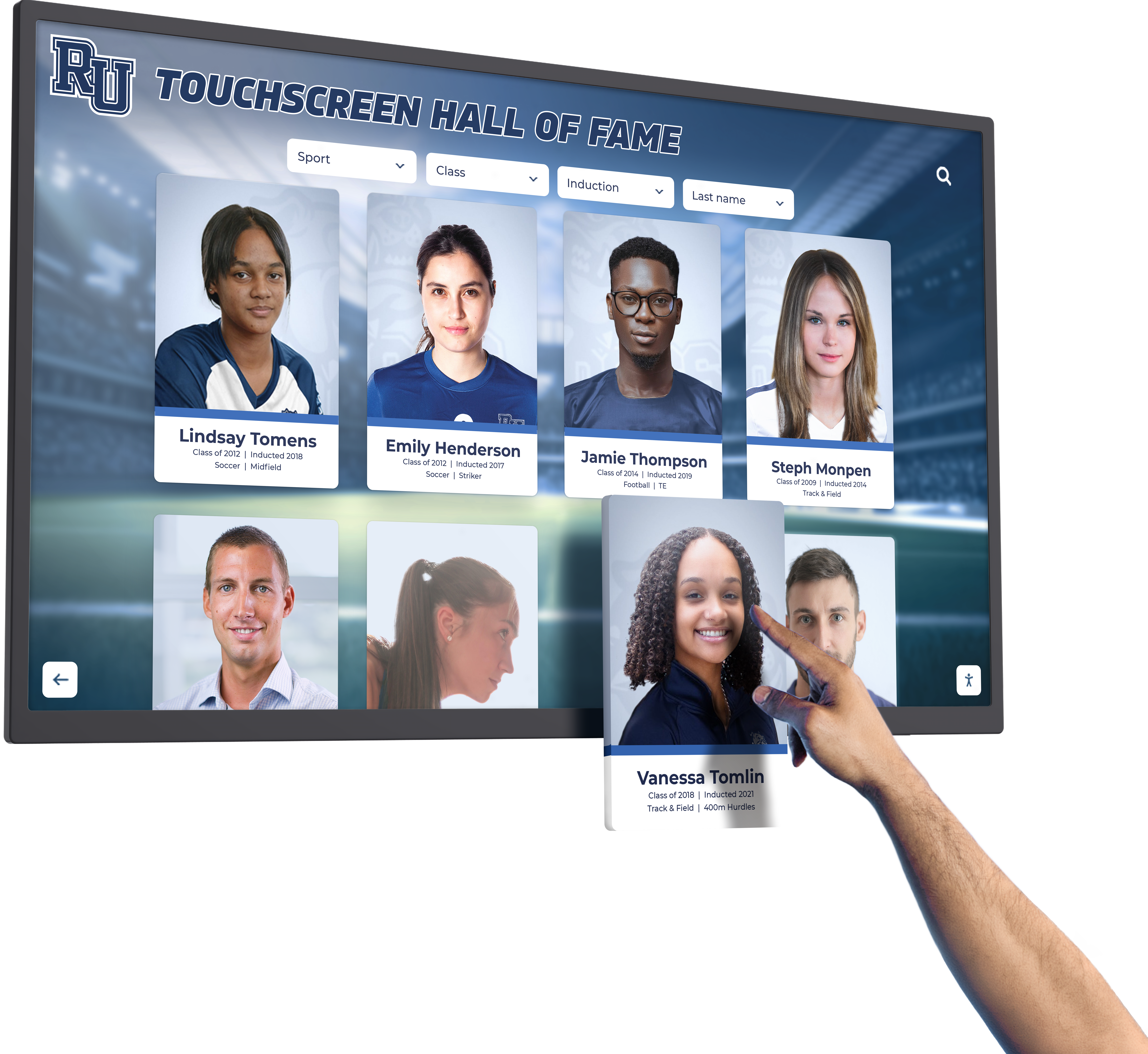
Touchscreen software solutions demonstrate clear advantages for interactive platforms in engaging viewers, showcasing comprehensive content, and maintaining current, professional presentation.
Content Strategies for Employee Recognition Displays
Compelling content transforms touchscreen displays from impressive technology into meaningful recognition that genuinely honors employees.
Essential Employee Profile Components
Comprehensive employee profiles should include:
Professional Information:
- Full name and preferred name
- Department and role
- Years of service with the organization
- Educational background and professional certifications
- Career progression within the organization
- Areas of expertise and specialization
Achievements and Recognition:
- Company awards and honors received
- Performance milestones and accomplishments
- Leadership roles and committee service
- Innovation contributions and process improvements
- Client testimonials and impact stories
- Professional certifications and continuing education
Personal Touches:
- Professional photograph in work environment
- Why they joined the organization
- Favorite aspects of their role
- Memorable achievements or project successes
- Personal interests and hobbies outside work
- Community involvement if comfortable sharing
Multimedia Elements:
- Video interviews discussing their work passion
- Colleague video testimonials expressing appreciation
- Action photos showing employees engaged in work
- Photos from company events or team activities
- Audio recordings of achievement stories
Peer and Client Testimonials
Colleague and client voices provide the most powerful employee recognition. Creating opportunities for peers and clients to contribute appreciation messages adds authentic emotional impact:
Collection Methods:
- Digital submission forms on company intranet
- Video recording sessions during team meetings
- Written testimonials collected through recognition platforms
- Anonymous submission options encouraging candid appreciation
- Regular “recognition rounds” where teams nominate colleagues
- Client feedback integration from satisfaction surveys
Effective Testimonial Questions:
- “How has this colleague made a difference to your work?”
- “What will you remember most about working with this person?”
- “Describe a moment when this employee demonstrated company values”
- “What makes this team member exceptional?”
- “What impact has this person had on our organization?”
Presentation Approaches:
- Text testimonials with colleague first names or initials
- Video testimonials with appropriate permissions
- Audio recordings of colleague voices reading messages
- Client commendation letters and feedback
- Team collective messages honoring individual members
Celebrating Career Milestones and Achievements
Recognition displays should acknowledge significant career moments:
Years of Service Recognition: Celebrate milestone anniversaries (5, 10, 15, 20, 25, 30+ years) with special content updates featuring career retrospectives, historical photos, and reflections on organizational changes witnessed across decades of service.
Award Acknowledgment: Highlight employees receiving company awards, industry recognition, professional certifications, patents, publications, or other professional recognition. Include award descriptions and significance to organizational goals.
Promotion Celebrations: Recognize career advancement and internal mobility, showcasing the organization’s commitment to employee development and celebrating success stories of employees who have grown within the company.
Project Success Stories: Feature teams and individuals behind successful projects, product launches, client wins, or operational improvements. Include project impact, team member contributions, and outcomes achieved.
Innovation Recognition: Celebrate employees who contribute innovative ideas, process improvements, cost savings, or new approaches that advance organizational objectives. Include implementation details and measurable impact.
Implementation Planning and Strategy
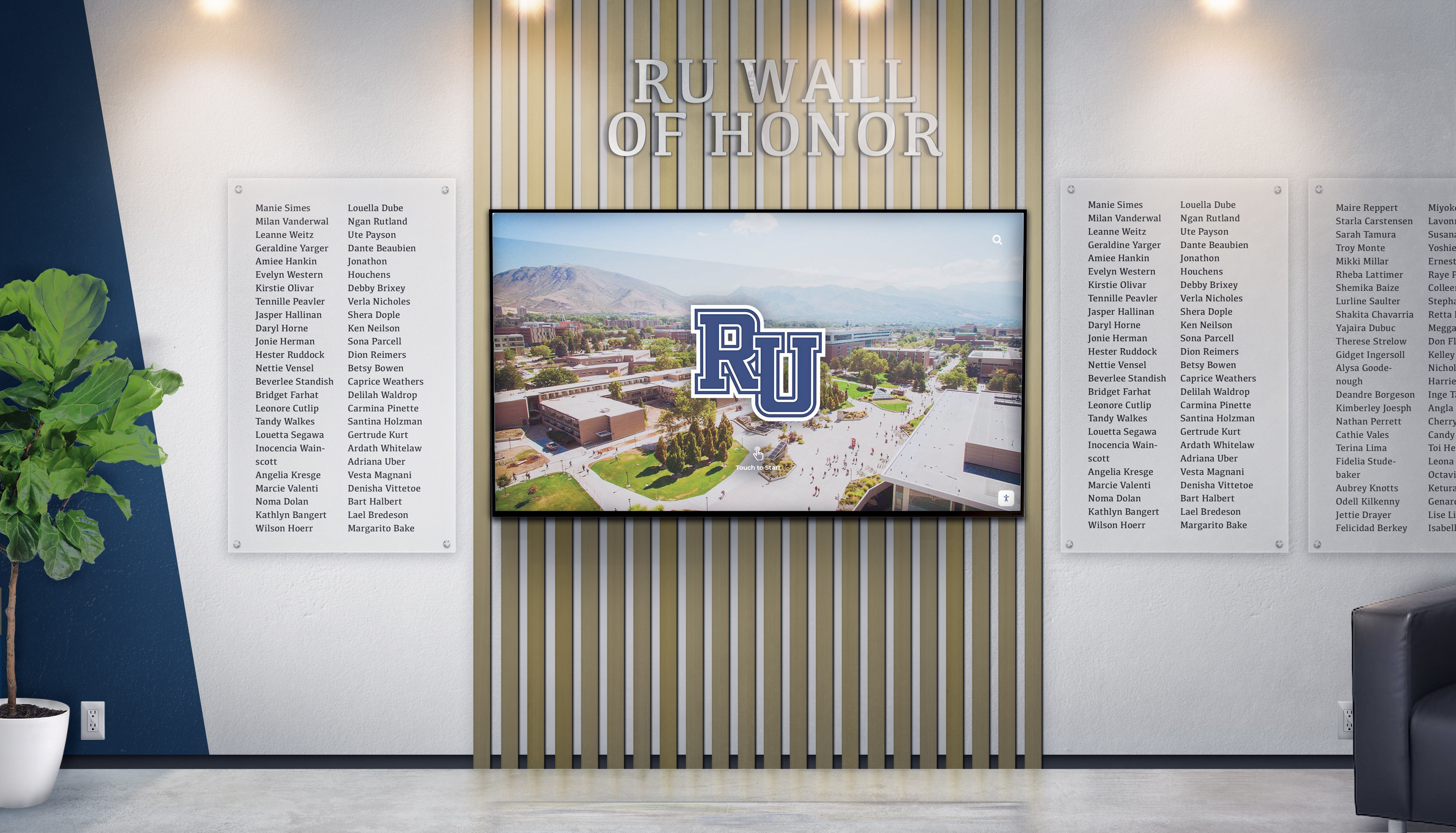
Successful touchscreen display implementation requires thoughtful planning addressing location, hardware, content development, and ongoing management.
Selecting Optimal Locations
Location dramatically influences display visibility and engagement:
High-Traffic Locations:
- Main entrance lobbies where employees and visitors pass daily
- Near reception areas where clients wait
- Employee break rooms and cafeterias where staff gather
- Elevator lobbies in multi-floor facilities
- Conference center lobbies before meetings and events
Location Considerations:
- Adequate stopping space for multiple viewers to gather comfortably
- Clear sight lines from major pathways attracting attention
- Appropriate lighting avoiding glare while ensuring visibility
- Accessible mounting heights complying with ADA requirements
- Proximity to power and network infrastructure
- Physical security preventing damage or tampering
Multi-Display Strategies: Larger organizations may benefit from multiple displays in different areas:
- Department-specific displays featuring team members
- Floor or building displays for multi-location organizations
- Specialized displays for innovation centers or research facilities
- Customer-facing displays in retail or hospitality environments
Hardware Selection and Specifications
Display Size Recommendations:
- Small offices (under 50 employees): 43-55 inch displays
- Medium businesses (50-250 employees): 55-65 inch displays
- Large corporations (250+ employees): 65-75 inch displays
- Multiple smaller displays often provide better coverage than single large displays
Touchscreen Technology: Commercial-grade capacitive or infrared touch technology provides responsive, reliable interaction. Infrared touch works well for larger displays (65"+) and accommodates any input method including fingers, styluses, or gloved hands.
Mounting Options:
- Wall-mounted installations for permanent, space-efficient placement
- Floor stand kiosks allowing flexible positioning and relocation
- Secure enclosures for public areas requiring vandalism protection
- Tilt-adjustable mounts accommodating optimal viewing angles
Computing and Connectivity: Displays require media players or computers running recognition software. Specifications should include:
- Sufficient processing power for responsive touch interaction
- Adequate storage for multimedia content libraries
- Reliable network connectivity (wired Ethernet preferred)
- Remote management capabilities for content updates
- Backup and recovery systems protecting content
For comprehensive guidance on hardware selection for digital recognition displays, evaluate factors including commercial-grade reliability, appropriate specifications for continuous operation, and total cost of ownership beyond initial purchase.
Content Development Process
Initial Content Creation:
Launching with comprehensive content requires significant upfront work but establishes the foundation for ongoing success:
Planning Phase (Week 1-2):
- Identify employees to feature initially
- Develop profile templates and content standards
- Create content collection forms and processes
- Schedule photography sessions
Data Collection (Week 3-6):
- Distribute employee information forms
- Conduct employee interviews for biographical content
- Schedule and complete professional photography
- Gather existing photos and documentation
- Collect initial peer testimonials
Content Creation (Week 7-10):
- Write biographical content for each employee
- Edit and process photographs professionally
- Record and edit video content if included
- Organize testimonials and supplementary materials
- Review all content for accuracy and consistency
Review and Refinement (Week 11-12):
- Employee review and approval of their profiles
- Leadership review ensuring policy compliance
- Final edits and corrections
- Complete content loading into software platform
- Comprehensive testing of all features and content
Realistic Timeline: Plan minimum 12-16 weeks from project initiation to public launch for thorough content development. Rushed launches with incomplete content diminish impact and require extensive post-launch remediation.
Budget Considerations
Cost Components:
Initial Investment:
- Display hardware: $1,500-$5,000
- Touchscreen interface: Included or $400-$1,000
- Media player/computer: $500-$1,500
- Mounting system: $250-$800
- Professional installation: $400-$1,000
- Software platform: $1,000-$3,500 first year
- Content development: $2,000-$8,000
- Total Initial: $5,650-$20,800
Ongoing Costs:
- Software licensing: $800-$2,500 annually
- Content management: $1,000-$3,000 annually
- Hardware maintenance: $300-$600 annually
- Network and power: $150-$400 annually
- Content updates: $800-$2,000 annually
- Total Annual: $3,050-$8,500
Funding Sources:
- Corporate operating budgets or facilities funds
- HR or talent management budgets
- Employee engagement program allocations
- Corporate communications budgets
- Foundation or diversity & inclusion initiative funds
- Capital improvement budgets for permanent installations
ROI Considerations:
While investment appears significant, compare against ongoing costs of employee turnover and recruitment. If recognition displays contribute to reducing turnover by even 2-3 employees annually in a mid-sized organization, the cost savings from retained talent (averaging $15,000-$30,000 per retained employee) substantially exceed recognition technology investment.
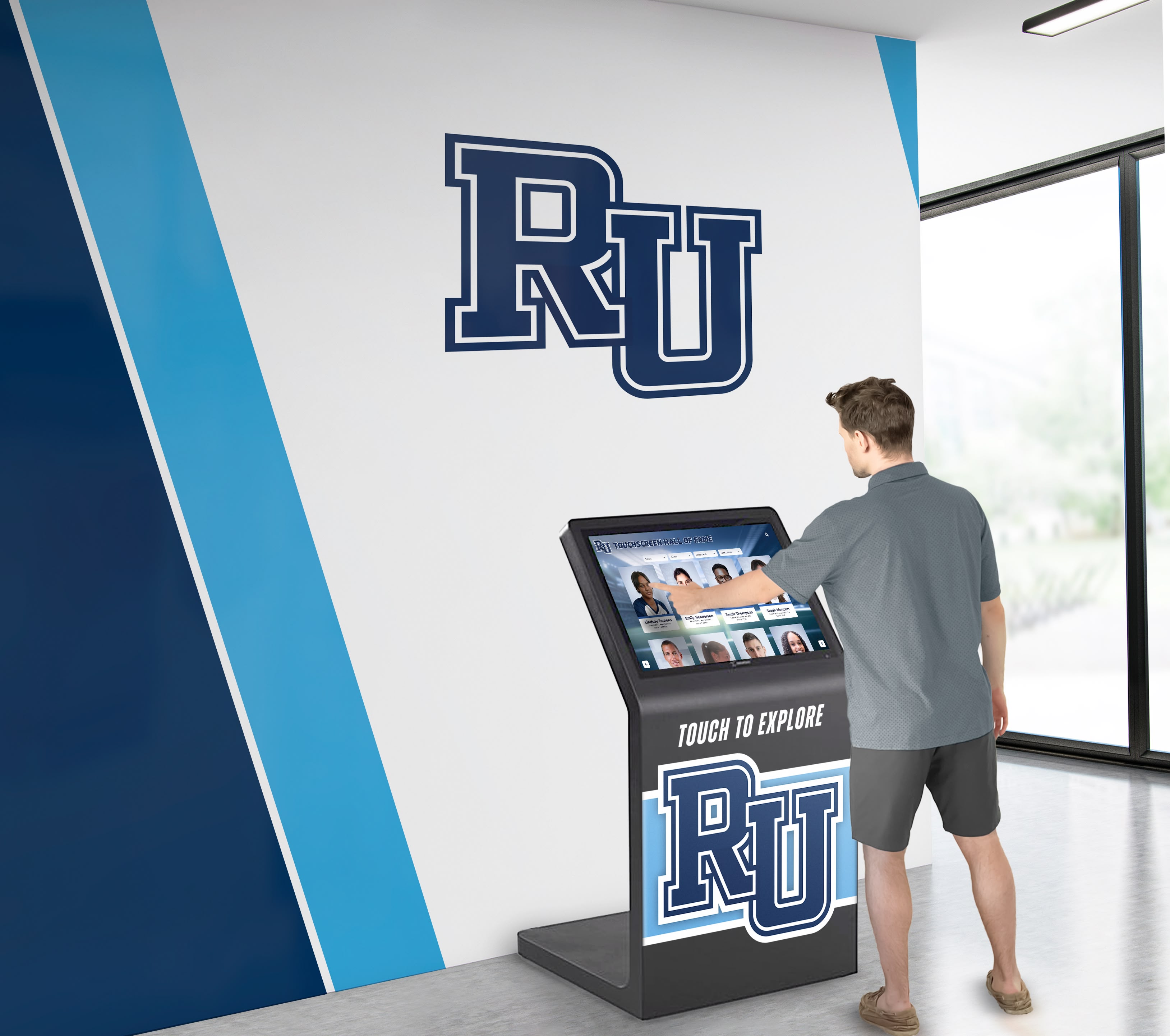
Solutions like Rocket Alumni Solutions provide purpose-built platforms specifically designed for recognition applications, offering content management tools, professional templates, interactive features, and support services that reduce implementation complexity while controlling costs.
Best Practices for Employee Recognition Displays
Ensuring Inclusive Recognition
Recognizing All Team Members: Comprehensive recognition should include:
- Employees across all departments and roles
- Remote and hybrid workers alongside on-site staff
- Part-time and contract workers contributing to success
- Support staff and administrative professionals
- Leadership and management teams
- Retired employees maintaining legacy connections
Leaving employees out—intentionally or accidentally—creates resentment and undermines the positive culture recognition programs aim to build. Budget time and resources to feature every team member contributing to organizational success.
Equitable Content Quality: Ensure consistent, high-quality content for all employees, not just executives or high-profile staff. Every team member deserves professional photography, comprehensive biographies, and meaningful recognition regardless of seniority or department.
Diverse Representation: Recognition content should reflect the diversity of your workforce. Highlight employees representing different backgrounds, career paths, departments, and tenure levels, ensuring all employees see themselves reflected in celebrated contributors.
Maintaining Content Currency
Content Freshness: Stale content diminishes engagement. Implement processes ensuring:
- New employee additions within first two weeks of employment
- Prompt updates for promotions, awards, and certifications
- Current photographs refreshed every 2-3 years
- Regular testimonial additions preventing repetitive content
- Seasonal content variations maintaining visual interest
- Archived or adjusted content for departing employees
Assigned Responsibility: Designate specific staff members responsible for content management:
- Content coordinator overseeing overall management
- Department liaisons collecting information from teams
- IT staff managing technical aspects and troubleshooting
- HR approval process ensuring policy compliance
- Employee volunteer committee providing content ideas and feedback
Without clear accountability, recognition displays languish with outdated content, undermining their purpose.
Protecting Privacy and Respecting Boundaries
Employee Consent: Obtain explicit permission before featuring employees prominently in public displays. Professional ethics and respect require consent for recognition content, particularly for:
- Photographs and video content
- Personal information beyond professional credentials
- Family or personal interest information
- Peer testimonials associated with specific employees
Content Boundaries: Establish clear policies about appropriate recognition content:
- Focus on professional achievements and work excellence
- Avoid potentially embarrassing personal information
- Respect cultural and religious sensitivities
- Maintain professional tone avoiding overly casual content
- Protect employee privacy regarding personal contact information
Integrating with Broader Recognition Programs
Employee recognition touchscreen displays work best integrated into comprehensive recognition strategies:
Complementary Recognition Methods:
- Formal award programs and ceremonies
- Regular recognition in team meetings or company communications
- Peer-to-peer recognition platforms
- Manager one-on-one acknowledgment
- Professional development opportunities as recognition
- Spot bonuses and incentive programs
Coordinated Communication: Feature recognition display content across multiple channels:
- Company newsletters and intranet highlighting featured employees
- Social media posts showcasing employee achievements
- External media coverage of exceptional contributions
- Recruitment materials showcasing company culture
- Client communications demonstrating team expertise
Advanced Features and Enhancements
Video Content and Multimedia Integration
Video content creates particularly powerful emotional connections. Consider incorporating:
Employee Interview Videos: Short 60-90 second videos featuring employees discussing why they love their work, memorable moments, or career highlights provide authentic insight into team member passion and dedication.
Colleague Video Messages: Collections of brief peer testimonials expressing appreciation create moving tributes. Film teams or individual colleagues sharing what makes specific employees exceptional.
Work Action Footage: B-roll footage showing employees engaged in work—leading meetings, collaborating with teams, serving clients—demonstrates excellence in action.
Career Journey Stories: For milestone celebrations or retirements, create documentary-style videos featuring career highlights, historical photos, and reflections from colleagues spanning years of service.
For comprehensive guidance on creating compelling video content, explore video production strategies for digital recognition displays.
Interactive Features Enhancing Engagement
Search and Browse Functionality: Intuitive navigation enabling users to:
- Search by employee name or department
- Browse by years of service or career milestones
- Filter by expertise areas or skills
- Discover featured employees through rotating spotlights
- Access alphabetical directories
Social Sharing Options: Allow employees and visitors to share recognition content:
- Generate QR codes linking to specific employee profiles
- Email profile links to interested parties
- Print-friendly profile formats for personal display
- Social media integration for appropriate content sharing
Contributor Features: Enable ongoing community participation:
- Submit recognition forms accessible from displays
- Vote for monthly employee spotlight features
- Sign digital appreciation cards for colleagues
- Record video messages at kiosk stations
Seasonal and Thematic Content
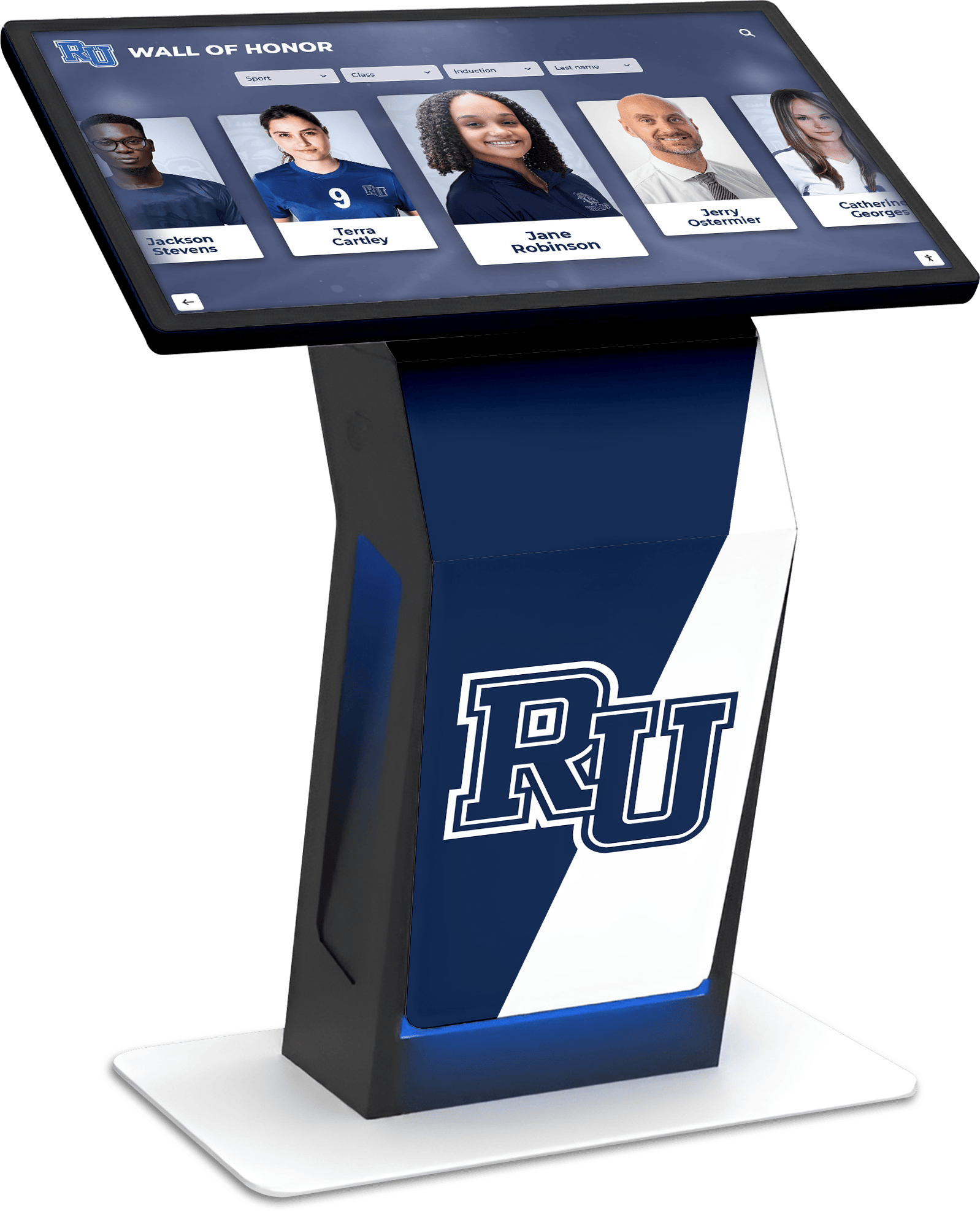
Rotating thematic content maintains fresh, engaging displays:
Employee Appreciation Week: Create special content highlighting all employees simultaneously with coordinated appreciation messages, special video compilations, and recognition from leadership.
Milestone Celebrations: Feature employees celebrating significant service anniversaries with historical retrospectives, career journey timelines, and colleague tributes.
Values-Based Recognition: Regularly spotlight employees exemplifying company values through specific actions, decisions, or sustained behaviors that demonstrate cultural alignment.
Department Spotlights: Rotate focus across different teams and departments, showcasing diverse contributions and building cross-functional appreciation.
Measuring Impact and Success
Quantitative Metrics
Display Engagement Data: Modern recognition software tracks valuable usage metrics:
- Number of daily interactions
- Average engagement time per session
- Most-viewed employee profiles
- Popular features and content types
- Peak usage times and patterns
- Search queries and browsing behaviors
Organizational Metrics: Connect recognition initiatives to business outcomes:
- Employee retention rates before and after implementation
- Employee satisfaction survey results
- Recruitment applicant quality and quantity
- Employee engagement indicators
- Internal mobility and promotion rates
Qualitative Feedback
Employee Responses: Gather feedback from recognized employees:
- Do employees feel genuinely valued and appreciated?
- What aspects of recognition are most meaningful?
- Are there concerns about privacy or presentation?
- What content additions would enhance profiles?
- How has recognition impacted job satisfaction?
Leadership Perspectives: Document organizational observations:
- Has company culture shifted toward greater appreciation?
- Do employees reference recognition displays in conversations?
- Has recruitment messaging incorporated recognition systems?
- Do visitors and clients engage with displays?
- What unexpected benefits or challenges have emerged?
ROI Measurement Framework
Calculating Recognition ROI:
Measure the financial impact of recognition technology investment:
Cost Savings from Reduced Turnover:
- Calculate average cost of employee replacement ($15,000-$30,000 per employee)
- Estimate turnover reduction attributable to improved recognition (2-5%)
- Multiply retained employees by replacement cost savings
- Compare against recognition system total cost of ownership
Productivity Improvements:
- Survey managers on perceived productivity changes
- Track project completion rates and quality metrics
- Measure employee engagement score improvements
- Correlate engagement increases with productivity research (typically 14-18% improvement)
Recruitment Benefits:
- Track time-to-fill improvements for open positions
- Monitor candidate quality and acceptance rate improvements
- Calculate cost savings from improved employer brand and reduced recruiting expenses
Industry-Specific Applications
Corporate Office Environments
Professional services firms, technology companies, and corporate headquarters use employee recognition displays to:
- Showcase thought leadership and industry expertise
- Celebrate innovation and patent achievements
- Recognize client service excellence
- Honor years of service milestones
- Build employer brand for recruitment
Healthcare Organizations
Hospitals, medical centers, and healthcare facilities implement recognition displays to:
- Celebrate clinical excellence and patient care
- Recognize research contributions and publications
- Honor compassionate care and patient satisfaction
- Acknowledge years of dedicated service
- Support retention in high-turnover environments
Manufacturing and Industrial Settings
Manufacturing facilities and industrial organizations use recognition systems to:
- Celebrate safety achievements and incident-free performance
- Recognize efficiency improvements and process innovation
- Honor quality excellence and zero-defect records
- Acknowledge technical expertise and skill development
- Build pride in production and operational excellence
Retail and Hospitality
Retail chains and hospitality organizations implement displays to:
- Recognize exceptional customer service
- Celebrate sales achievements and performance
- Honor manager and supervisor leadership
- Acknowledge tenure in high-turnover industries
- Build team culture across multiple locations
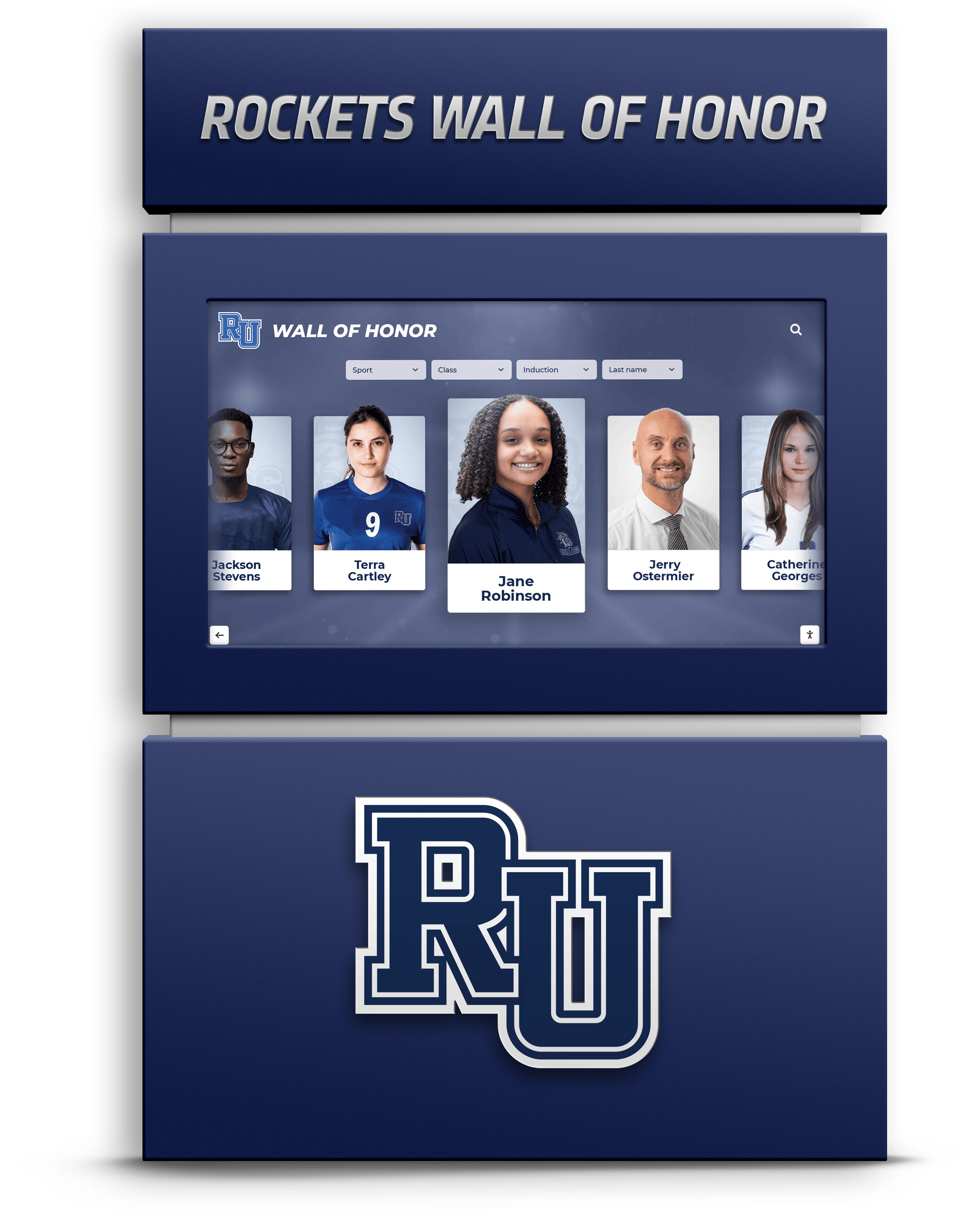
For organizations exploring touchscreen software for recognition, understanding industry-specific applications helps tailor implementations to organizational needs and culture.
Conclusion: Investing in Recognition Technology That Matters
Employees drive organizational success through their expertise, dedication, innovation, and commitment. They solve problems, serve clients, collaborate with colleagues, and carry organizational missions forward every day. Their contributions shape outcomes, influence trajectories, and create lasting impact extending far beyond individual roles.
This extraordinary contribution deserves recognition matching its significance. Interactive touchscreen displays provide organizations with powerful platforms to honor employees with professional, engaging, permanent tributes that celebrate excellence while strengthening cultures where team members feel genuinely valued.
The investment in employee recognition technology represents more than displays and software—it demonstrates organizational commitment to the people who make success possible. It tells employees “You matter. Your work is seen. Your contributions are celebrated. You are valued.” In an era of talent shortages and retention challenges, these messages carry extraordinary weight.
Key Success Factors for Employee Recognition Touchscreens:
- Feature all team members with equitable, high-quality content
- Include rich multimedia showcasing employees’ personalities and impact
- Maintain current content through defined management processes
- Integrate displays into comprehensive recognition cultures
- Measure engagement and continuously improve based on feedback
- Protect privacy while celebrating professional excellence
- Connect recognition to retention, recruitment, and culture goals
Ready to transform employee recognition in your organization? Solutions like Rocket Alumni Solutions provide purpose-built platforms designed specifically for workplace recognition, offering intuitive content management, professional templates, interactive features, and ongoing support that makes honoring employees both meaningful and sustainable. Your team members deserve recognition that matches their impact—interactive touchscreen displays deliver tributes worthy of exceptional contributions.




































